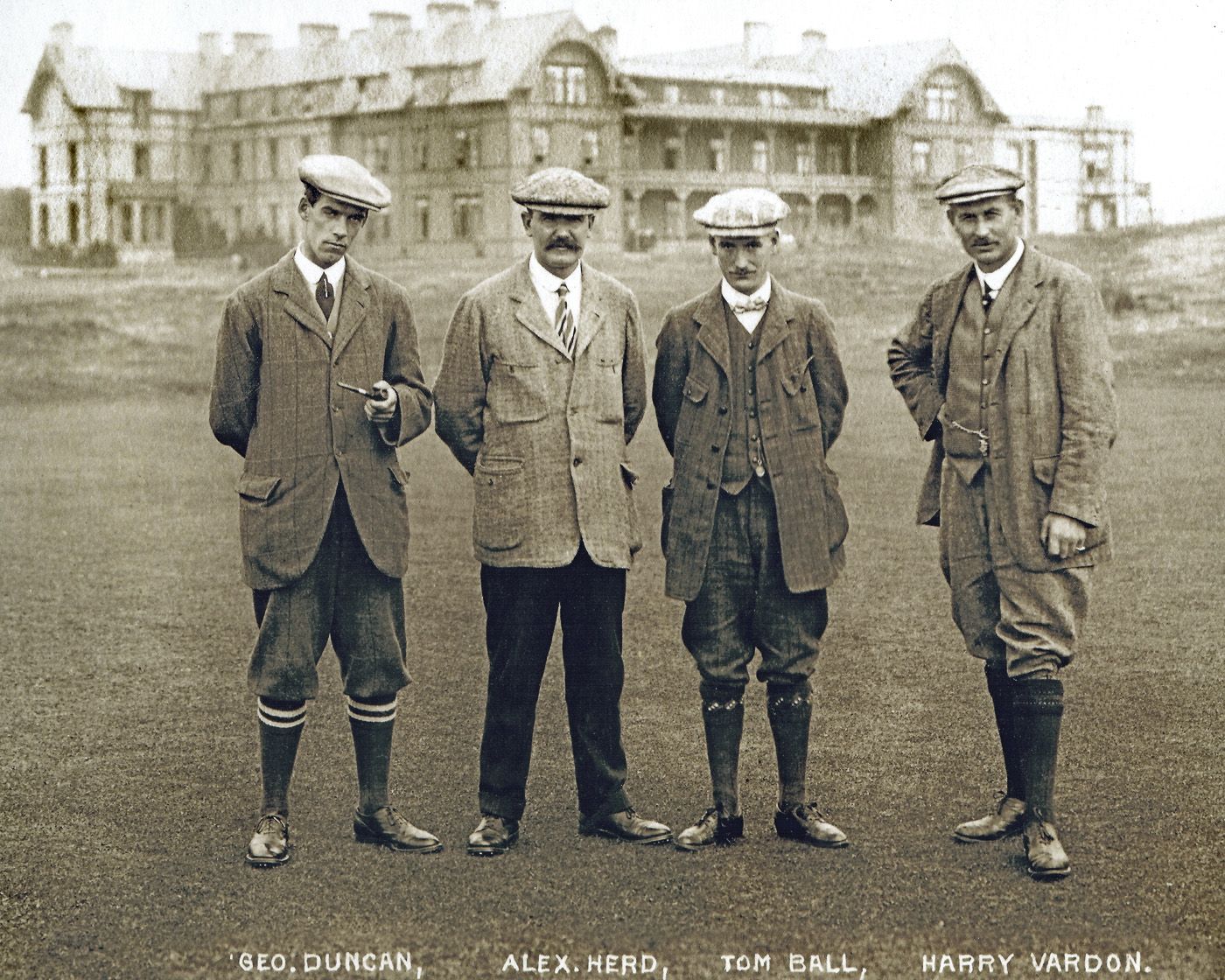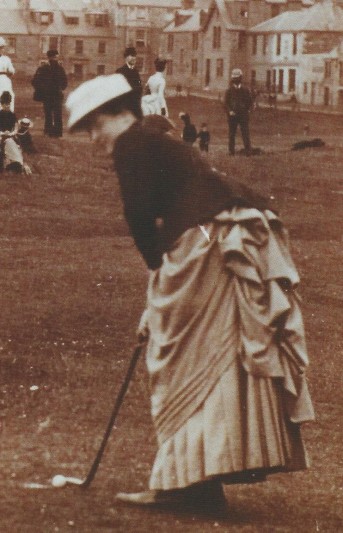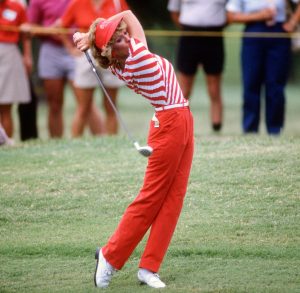What Types Of Clothing Did Golfers Wear?
In the early 19th and 20th centuries, golfers would wear knickers or short pants that ended below the knee and heavy tweed jackets. Their ensembles include starch shirts, neckties, and matching tweed caps.

Golf wear was meant to show authority and wealth; the more formal the outfit, the more money you had.
Unlike other sports, golf doesn’t have a uniform. Players can express their own unique style and enjoy the excitement of choosing an outfit before getting out there on the course. But things weren’t always that way. In the early days of golf, style wasn’t as important as it is today.
Let’s dive into the history of golf fashion and how certain trends have influenced the way golfers dress today.
Whether you’re a golf pro or a beginner, you’re likely familiar with how golfers typically dress. Maybe you’ve seen groups of students play “pub golf” or perhaps you’ve watched a few matches on TV.
Whatever the case, you probably have an idea of what golf fashion looks like. From polo shirts to above-the-knee shorts to the “driver hat” (flat cap), golf clothing has a distinct look that’s unmistakable from other fashion.
Golfing has quite a rich history when it comes to apparel. From winter-friendly attire to brave the elements in Scotland to today’s modern golf clothes, let’s dive into the history of golf fashion over the years. Where did it all start?
- The first golf clothing: The first game of golf took place during the 15th century in Scotland. The climate in Scotland is often cool, rainy, and windy. So, players wore thick, heavy fabrics like tweed and plaid.
- To protect themselves from the wind blowing off the water at courses like St. Andrews, golfers sported knickerbockers (knickers), which are short pants that end right below the knee. Players paired these knickerbockers with flat caps. Elements of this style are still present today.
- The early 1900s: A 1918 advertisement in Vanity Fair proved to be a pivotal moment in golf fashion. This is when the single-breasted jacket, waistcoat, long socks, and golf cap became popular. Back then, this more formal style of dress represented what it meant to be a well-dressed golfer.
- The 1920s: The booming American economy resulted in the glamour of the Roaring Twenties. This elevated golf to an even more formal look. Single-breasted jackets, neckties, and long stockings were popular.
- The 1930s and 40s: In the 30s and 40s, golf fashion took a more casual turn. Golfers began to move away from knickerbockers and embraced long flannel trousers.
- The shirt and tie also became less common. The 1933 U.S. Open took place during a heatwave, which influenced players to wear more casual, lightweight clothing. This style began to stick and has strongly influenced what golfers wear today.
- Modern-day golf attire: Today, golfers tend to wear knit, collared golf shirts or vests with chinos or other casual trousers that are lightweight and roomy. Polo shirts, two-tone golf shoes, visors, and sun hats are also popular.
How Fashion Got into the Swing of Golf
After the first swings in Scotland, golfers didn’t really think about how they looked on the course. They mainly dressed for the sake of comfort and practicality, and not to look great and perform better.
This led to golf looks that weren’t necessarily fashion-forward. Muted, plaid materials, ill-fitting slacks, and dull colors weren’t particularly easy on the eye.
Today’s golfer, on the other hand, pays more attention to what they wear on the course. In fact, for many of them, looking good is just as important as how they play the game. Fashion-forward golfers enjoy getting dressed before a game.
They love bringing individuality to a sport that encourages you to be yourself. Golfing doesn’t have a uniform, so why should golfers dress the same?
As golf has become a professional sport, PGA players are like celebrities. They’re all over television, the news, and the internet. They get paid to golf, and hundreds of thousands—if not millions—of people see them playing the sport.
So, it’s no wonder many professional golfers are using the sport’s lack of a dress code to find their own look. Yet, they still focus on practicality at the same time. The right pocket in the pants has to be big enough to hold balls, tees, markers, and divot fixers.
Players should easily be able to reach in when they get to the tee box and find what they need, without having to adjust their underwear afterwards.
The clothing should also have a natural flow to it. Clothes should be loose enough to easily maneuver in, but not too baggy to the point where they look goofy. Shirts should be stylish, but they need to have moisture-wicking material so that they don’t stick to the body when sweating.
So, as you can see, golfers have been a lot more strategic about how they dress before a tournament or quick game of golf.
In other words, the shifts in golf fashion didn’t solely come from a shallow place. They also came from a “we want to be better” place. Golfers want to look stylish and trendy, while at the same time performing at the highest level.
This way of thinking has inspired recreational players as well. They want to enjoy a game of golf to help them relax and wind down from a long week.
But at the same time, they want to look nice, like they put some thought into their outfit. When playing with friends and colleagues, golfers don’t want to be known as the “one who can’t dress”.
Throughout this time, women remained skirted. Tailored sports dresses that were the precursors to the shirtmaker dress emerged in the late 1920s and 1930s; tailored separates alternated with the dresses into the post–World War II years.
Skirts were in keeping with the fashions of the time, hovering around the knee in length, usually gored or relaxed with inverted tailored kick pleats front and back to allow movement and ease.
They were coupled with tailored shirts and sweaters. Bermuda shorts, the sportswear darlings of the mid-1950s, hitting just above the knee and worn with knee socks, became preferred garments for both men and women at that time and continue to be worn for golf in the first years of the twenty-first century, though women usually wear them with short socks or sockets that come only to the ankle.
Shorts and skorts (shorts with a skirt-like flap extending from the side seam three-quarters of the way across the front of the garment to give the appearance of a skirt) are also part of a woman golfer’s wardrobe.
Professional golfers, both male and female, wear long, loose, comfortable trousers or long shorts, with belt loops and belts. Most golf clubs have a policy of a collared shirt, whether woven or knit.
Most frequently, these are polo shirt styles. The club name or emblem is traditionally embroidered on the left breast, and it also appears on the baseball caps or sun visors that have been adopted for golf.
Most clothes for golf were practical cotton, mainly if worn in warm or moderate climates. Of course, golf fanatics who play as much as they can throughout the year, even in the north, wear layers that keep them warm, with sweaters and zipper-front waterproof jackets.
With the introduction of manufactured fibers, notably polyester, in the 1960s that spawned the ubiquitous “no care” polyester/cotton fabrics, golf clothes took on a more daring coloration in keeping with the fashions of the 1960s,
Giving golf clothing the reputation, that continues to linger, of colorful, often garish clothing that does not attempt to be stylish. Even the most significant sartorial symbol of golf, the highly coveted Master’s jacket, is a bright, unforgettable green that few would choose to wear off the links.
Overall, golf clothing might be termed fossilized fashion, becoming almost a parody of itself in its adherence to conventional forms.
Golfers are stereotypically known to wear clothes codified by traditions rather than new fashions. They choose practical, loose, and pragmatic outfits in keeping with long outdoor walks broken periodically by the need to swing a golf club.
Why do golfers wear the clothes they wear?
While the ancient origins of the game are much debated, The modern game of golf is widely known to have originated back in 15th century Scotland, where the first written record is James II’s banning of the game in 1457 with the intention of men focusing on military training over leisure.
However, the ban was lifted by James IV in 1502 when he became a golfer himself. Even if you’ve never played golf before, most people will have some kind of idea of the clothes a golfer wears, and the attire is just as traditional as the game itself.
Men’s Clothing
Back when the game began in Scotland, players would piece together their outfits based on comfortability to protect them against the cold weather. Players would wear jackets made of thick fabrics such as plaid or tweed and pair these with a pair of plus fours or ‘knickerbockers’.
Knee-high breeches, starched-collar shirts with ties, and a small tweed cap would complete the look, and while this type of attire has been abandoned in professional play it can still be seen on some courses around Scotland.
Men’s Golf Clothes 1920s
The Roaring Twenties saw a surge in popularity for golf and after gaining popularity among wealthy circles, the clothes were elevated to a more formal look.
n 1918 A Vanity Fair article stated that the well-dressed golfer should wear a single-breasted jacket, waistcoat, long socks, and golf cap. Upper-class players took their fashion to the next level with patterned long socks, two-tone shoes, shirts and ties, and knitted cardigans.
The 1930s saw the clothes worn by players take a more casual turn. Golfers began moving away from the classic knickerbocker style and opted for long flannel trousers.
Following the heatwave at the US Open in 1933, golfers switched the heavier fabrics for more lightweight casual clothing. By the 1950s, it was no longer customary for men to be seen in formal grey suits as they opted to dress in more colored fabrics.
The Second World War saw a change in the way clothes were made. Mass production was developing and synthetic fabrics were coming into fashion, taking over from such materials as cotton. The tennis shirt was almost universally adopted as standard golf attire, and many golf courses and clubs today require Golf shirts as part of their dress code.
It is common nowadays for Golf clothes to be much more casual, but most clubs will still require a standard dress code which is always worth checking before you play. Male golfers often tend to wear golf shirts made of polyester or mercerized cotton partnered with chinos or other casual trousers in a lightweight fabric. Polo shirts are also popular, as are two-tone golf shoes.
Women’s Clothing

Women’s Golf Clothes
Women in the 19th and 20th centuries were not allowed to play golf as a competitive sport but only as a leisure activity. Victorian golf dresses included crinolines, bustles, and multiple petticoats and heels. Which was hardly the most practical attire for playing in.
It wasn’t until the 1920s that women could have fewer layers while golfing. They were allowed to wear a single-layer skirt cut below the knee and stockings with a suit-style jacket.
Golf shoes for women were still not invented, and it’s shown that at this time, women were still wearing heels. 1933 saw the first time women were seen wearing trousers on the course, however, it was still considered incredibly scandalous and didn’t become common dress until many years later.
The 1950s were the beginning of liberation when it came to hem lengths for women, offering the freedom to wear skirts above the ankle. With increased mobility on the golf course, these skirts were paired with a blouse and layered with a cashmere sweater. In warmer weather, sleeveless blouses were acceptable.
The waistline was also a topic of debate for women on the course. “sack dresses” were viewed as the modest choice as they were a formless and unbelted dress that hung straight from the shoulder to the hemline, many women, however, opted for dresses that were more fitted and had a waistline.
Everyone is familiar with the Bold colors and patterns that began to make their way into people’s wardrobes in the 1960s and women’s golf clothes were no exception to the trend. Hem lengths inched upward and the skort was introduced.
This made it possible to wear knee-length skirts. This decade saw Waistlines disappear, making way for free-flowing tunics and culottes. Comfort was favorable at the time, leading the way for flowy dresses and skirts on the golf course.

Women’s Golf Clothes 1970s
The 1970s waved goodbye to the golf dress and subbed in a more unisex style. Women began wearing pants suits, form-fitting pants, and platform shoes as statements of power and equality, Slacks replaced the golf dress.
and clothes that complimented the waistline were reintroduced. Polyester was the fabric of choice and bright colors were very prominent. It wasn’t uncommon to see women on the first tee sporting bright red or yellow flares.
Despite the shift from vibrant colors to subdued tones, women’s clothing styles remained more or less the same during the ’80s and ’90s. The ’90s introduced the wide-brim visor that can still be seen on the courses today.
During the 2000s Women began to push the boundaries of country club and resort golf standards by choosing clothing that fit their desire to wear fabrics and cuts that could perform just as well as they did.
Sleeve lengths shrank and companies began to focus on using more breathable, moisture-wicking fabrics like polyester.
Popular styles for women today have remained very similar to those in the 2000s, these include a matching two-piece of a shirt and skirt or trousers, plus accessories like visors, sun hats, and belts.
